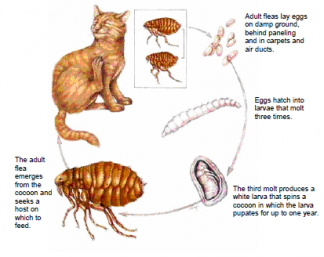

What are fleas?
Fleas are tiny parasites that range from 1-6mm in length, dark brown to black in colour. For their size, they have superhuman strength, with some being able to jump up to 30cm. As impressive as that is, the sole purpose for this is to jump on our beloved pets and feed from their blood.

Life cycle
A fleas lifecycle starts from eggs which hatch into larva, maturing to pupa and eventually becoming adults. This can take as little as 18 days in the optimal conditions, however it can take as long as 6-12 months if the conditions are suboptimal. Adult fleas are the only fleas that can be seen on your pet. Eggs are laid and fall off our pets concentrating in areas where they spend most of their time, especially where they sleep. After hatching on the ground, they lie in wait to jump onto a potential host. Adult fleas account for only 1% of the entire flea population so the majority are present in the environment and can cause reinfection of our pets.
Why are they bad?
Fleas feed off small meals of blood from your pet, their bite’s cause great irritation to your pet. Your pet will scratch and itch to the point of harming themselves because it is so itchy. In large quantities, they will cause malnourishment and possibly anaemia. Even a single bite can cause an allergic reaction leading to severe irritation and infection. There are even certain diseases that can be spread by fleas.
Then how can I get them under control?
Prevention is simple with monthly treatments whereas dealing with an infestation takes time, patience and effort.
How can I tell if my pet has fleas?
If you want to try and find one you can try parting the fur down to the skin in multiple areas, focus on areas away from the light such as at the base of the tail or groin area. Just because you cannot find a flea does not mean that there are none, remember only 1% of the flea population would be on your pet. Adult fleas also leave behind their droppings which may appear like dirt in the fur. Using a moist cloth dab the ‘dirt’ and if it turns a little red, this confirms the presence of flea droppings as it is digested blood. It can be difficult to tell if your pet has fleas but if you have noticed an increase in itchy or the skin is appearing red and irritated it is important to see you vet to get to the bottom of the cause.
Intestinal Worms
There are many type of worms. Cats and dogs are most commonly infected by roundworms, hookworms, tapeworms or whipworms. They can lead to a decrease in appetite, diarrhoea, vomiting and in severe cases malnutrition and death. Even as a puppy or kitten straight from the breeder it is likely that your pet will have a parasite burden already. There is a chance for these parasites to be passed on to a human so ensure after cleaning up after your pet you thoroughly wash your hands. While they are young with a developing immune system it is important to worm them regularly; as a rough guide this means once every 2 weeks until 12 weeks of age then monthly until 6 months. Once they reach 6 months of age we recommend worming once every three months. There are many worming products on the market, some not as good as others. Please contact us for some advice and we can point you in the right direction.